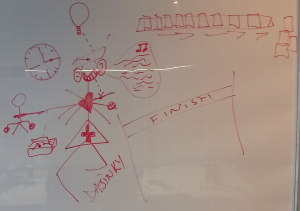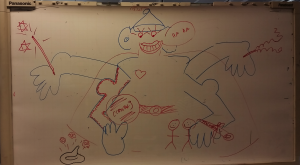In this article
What is a Team Charter and why make one?
What’s in a Team Charter?
How to make the charter
What is needed for a high quality Team Charter?
How to make sense of the team charter
What is a Team Charter and why make one?
Team Charters (aka”Social Contract” or “Working Agreement”) are explicit agreements made between team members that are guidelines for their future behaviours. The charter is created by the team for the team to use, rather than an imposed workplace values document.
A well-designed charter will help with clarity of expectations in the team, create focus, help the team members understand what they need to be doing, and provide a basis for decision making. Creating a team charter can have a positive impact on the performance for both new and existing teams.
The team charter needs to cover the following:
- How team members will work together
- How they will make decisions
- How they share accountability
- How they will deliver
- Their performance expectations
- Clarity of the team boundaries and external stakeholders
Making the team charter needs to be a collaborative and inclusive process, and can be a great opportunity to establish some cohesion in the team.
What’s in a Team Charter?
To make a charter the team members need to consider a few dimensions:
- personal
- teamwork
- norms
- rewards and sanctions
These are covered in more detail below.
Personal
The personal dimensions of the charter are both the individual factors of the team members and their interaction styles and preferences.
- Personal background information – this is very important for new teams
- Contact information and preferred contact method(s) – important for non-collocated teams, or teams that are not working together all the time
- Availability and preferred working hours – again, this is important for non-collocated teams or teams that are not working together all the time
- Their individual strengths and weaknesses with respect to the work of the team; this may include relevant work experience
- Preferred working styles – solo work, working with another or a group, a mix of these.
- What are their personal goals for being in the team
- Anything they think is pertinent for the team or the task of the team
Teamwork
- What is the vision of the team
- What are does the team need to deliver
- What is the timetable for delivery
Norms
Norms are the expectations (often assumptions) of what kind of behaviour is acceptable in the team. These are often implicit, and the Team Charter gives the teams an opportunity to make these explicit. The needs to cover items such as:
- Meeting attendance
- Tasked performance and quality
- Idea contribution
- Cooperation, attitudes and conflict
- Decision making process
- Shared leadership
- Anything else the team identifies
Rewards and sanctions
Rewards and sanctions within a team are, as with norms, often implicit. When developing a charter it is important for the team to explicitly address these two items, including spelling out how the team will:
- Ensure expected contributions and performance levels in the team
- Reward members for success
- Manage or sanction poor performance
How to make the charter
There are many ways the team could do this; here are two:
Method 1: Brainstorming
Arrange a meeting with the team to make the charter.
As part of arranging the meeting send out a list of items (from the “Personal” section above) which the team members need to prepare prior to the meeting.
At the beginning of the meeting reiterate the agenda, and either offer to take any notes or have someone volunteer to do that.
Have the team members share their personal items (someone will need to consolidate these and give them to everyone in the team). This will probably result in some challenges around the ways people like to work and be contacted. These will need to be resolved before moving on to the team elements of the charter.
For teamwork, norms and rewards and sanctions elements in the charter, introduce each section and have the team brainstorm their thoughts on what needs to be in the charter. The most effective process here is to have everyone write their own thoughts down before sharing with the team (rather than going around the group and asking for their thoughts). Someone will need to consolidate the agreed output for each of these sections.
Once the team has completed the charter it needs to be written up and shared with all team members. For teams that are collocated a large copy of the charter in the work area can be a good reminder of how they are expected to work together.
Method 2: Best team member
As with the brainstorming approach, arrange some time and have the team members come prepared with their personal responses.
When the team comes to working out the team elements of the charter have the team make a drawing of the “Best Team Member”. The best team member is a sketch of an individual who incorporated all of the best elements of a member of the team, so it’s going to be a very odd looking person – no matter how good the team is at drawing. If the team has more than four members, split the team in two do this on two large pieces of paper. Whilst the team is drawing prompt them with questions regarding the teamwork, norms and rewards and sanctions elements of the charter and have these incorporated into the drawing.
Above are examples of a best team member drawing.
When the team has finished their drawings have them explain these to each other whilst capturing some of the salient points on a whiteboard (or any other written medium). Use these explanations and drawings to fill in the charter.
What is needed for a high quality Team Charter?
In their research on the effectiveness of charters on team performance, Mathieu & Rapp proposed that high quality comes from a complete and consistent charter. Completeness is the thoroughness and depth of the elements of the charter; where:
- low quality would be something like”We will meet regularly”, and
- high quality would have a schedule of meetings with details on where, when and duration with procedures for team members to follow if they can’t attend.
Consistency is how the separate elements of the charter work together. Mathieu & Rapp give an example of inconsistency where the team states they value consensus–but will vote in instances of disagreement.
How to make sense of the team charter
Most of the information in this article is from either personal experience or Mathieu & Rapp (2009). The following will go further in helping to understand the Team Charter, particularly how it works.
Change – Research on how teams develop over time has demonstrated that work practices can be tacitly established within minutes of the team coming together, and that these practices are extremely difficult to change once established (Gersick (1988, 1989)). Using the team charter can help to make the work practices of the teams explicit, allowing established practices to be challenged and improved.
Motivation – There is a large body of evidence that shows when people work together, they tend to work less than if they were working alone (see Social Loafing or Free riding). Establishing specific performance standards within the team can help to mitigate the effect of Social Loafing within a team. Having established sanctions for failing to meet the team performance standards also gives the team more latitude to self-manage.
Conflict – Conflict can be a destructive force within teams. The research on the positive effects of conflict have given mixed results over the years and the current thinking is that when conflict is individually driven (such as competing behaviours) it has a negative effect on performance (DeChurch, Mesmer-Magnus, Doty (2013)). Alternatively, when the conflict is open and collaborative, it can have positive impact on team performance. The team charter can establish rules for managing individual conflict if it arises, and develop a more open and collaborative process for managing team level conflict.
References
DeChurch, L.A., Mesmer-Magnus, J.R., Doty, D.(2013). Moving Beyond Relationship and Task Conflict: Toward a Process-State Perspective. Journal of Applied Psychology,98(4), 559–578
Gersick, C. J. (1989). Marking time: Predictable transitions in task groups. Academy of Management Journal, 32, 274-309.
Gersick, C. J. (1988). Time and transition in work teams: Toward a new model of group development. Academy of Management Journal, 31, 9-41.
Mathieu, J. E., & Rapp, T. L. (2009). Laying the Foundation for Successful Team Performance Trajectories: The Roles of Team Charters and Performance Strategies. Journal of Applied Psychology, 94(1), 90-103. doi:10.1037/a0013257


